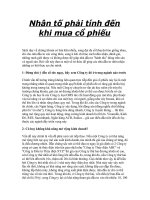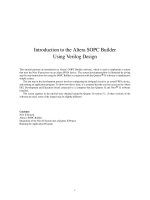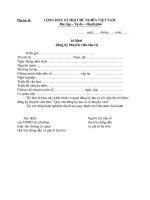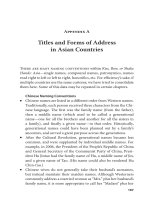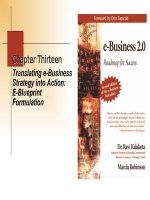Tài liệu LINQ to SharePoint DSL Extension for Visual Studio 2010 ppt
Bạn đang xem bản rút gọn của tài liệu. Xem và tải ngay bản đầy đủ của tài liệu tại đây (2.55 MB, 90 trang )
LINQ to SharePoint DSL Extension
for Visual Studio 2010
Version 1.3.2
2011/05/12
Powered for:
User Guide
[LINQ TO SHAREPOINT DSL EXTENSION FOR VS2010 – USER GUIDE]
1-2 | P a g e
Copyrights (c) 2011 Microsoft
Author: Olivier CARPENTIER
Microsoft Consulting Services
License terms
Different license terms apply to different file types:
- Source code files are governed by the MICROSOFT PUBLIC LICENSE (Ms-PL) (INCLUDED BELOW).
- Binary files are governed by MSDN CODE GALLERY BINARY LICENSE (INCLUDED BELOW).
- Documentation files are governed by CREATIVE COMMONS ATTRIBUTION 3.0 LICENSE (INCLUDED BELOW).
MICROSOFT PUBLIC LICENSE (Ms-PL)
This license governs use of the accompanying software. If you use the software, you accept this license. If you do not accept the
license, do not use the software.
1. Definitions
The terms “reproduce,” “reproduction,” “derivative works,” and “distribution” have the same meaning here as under U.S. copyright
law.
A “contribution” is the original software, or any additions or changes to the software.
A “contributor” is any person that distributes its contribution under this license.
“Licensed patents” are a contributor’s patent claims that read directly on its contribution.
2. Grant of Rights
(A) Copyright Grant- Subject to the terms of this license, including the license conditions and limitations in section 3, each
contributor grants you a non-exclusive, worldwide, royalty-free copyright license to reproduce its contribution, prepare derivative
works of its contribution, and distribute its contribution or any derivative works that you create.
(B) Patent Grant- Subject to the terms of this license, including the license conditions and limitations in section 3, each contributor
grants you a non-exclusive, worldwide, royalty-free license under its licensed patents to make, have made, use, sell, offer for sale,
import, and/or otherwise dispose of its contribution in the software or derivative works of the contribution in the software.
3. Conditions and Limitations
(A) No Trademark License- This license does not grant you rights to use any contributors’ name, logo, or trademarks.
(B) If you bring a patent claim against any contributor over patents that you claim are infringed by the software, your patent license
from such contributor to the software ends automatically.
(C) If you distribute any portion of the software, you must retain all copyright, patent, trademark, and attribution notices that are
present in the software.
(D) If you distribute any portion of the software in source code form, you may do so only under this license by including a complete
copy of this license with your distribution. If you distribute any portion of the software in compiled or object code form, you may
only do so under a license that complies with this license.
[LINQ TO SHAREPOINT DSL EXTENSION FOR VS2010 – USER GUIDE]
1-3 | P a g e
Copyrights (c) 2011 Microsoft
Author: Olivier CARPENTIER
Microsoft Consulting Services
I The software is licensed “as-is.” You bear the risk of using it. The contributors give no express warranties, guarantees or conditions.
You may have additional consumer rights under your local laws which this license cannot change. To the extent permitted under
your local laws, the contributors exclude the implied warranties of merchantability, fitness for a particular purpose and non-
infringement.
MSDN CODE GALLERY BINARY LICENSE
You are free to install, use, copy and distribute any number of copies of the software, in object code form, provided that you retain:
• all copyright, patent, trademark, and attribution notices that are present in the software,
• this list of conditions, and
• the following disclaimer in the documentation and/or other materials provided with the software.
The software is licensed “as-is.” You bear the risk of using it. No express warranties, guarantees or conditions are provided. To the
extent permitted under your local laws, the implied warranties of merchantability, fitness for a particular purpose and non-
infringement are excluded.
This license does not grant you any rights to use any other party’s name, logo, or trademarks. All rights not specifically granted
herein are reserved.
CREATIVE COMMONS ATTRIBUTION 3.0 LICENSE
THE WORK (AS DEFINED BELOW) IS PROVIDED UNDER THE TERMS OF THIS CREATIVE COMMONS PUBLIC LICENSE (“CCPL” OR
“LICENSE”). THE WORK IS PROTECTED BY COPYRIGHT AND/OR OTHER APPLICABLE LAW. ANY USE OF THE WORK OTHER THAN AS
AUTHORIZED UNDER THIS LICENSE OR COPYRIGHT LAW IS PROHIBITED.
BY EXERCISING ANY RIGHTS TO THE WORK PROVIDED HERE, YOU ACCEPT AND AGREE TO BE BOUND BY THE TERMS OF THIS
LICENSE. TO THE EXTENT THIS LICENSE MAY BE CONSIDERED TO BE A CONTRACT, THE LICENSOR GRANTS YOU THE RIGHTS
CONTAINED HERE IN CONSIDERATION OF YOUR ACCEPTANCE OF SUCH TERMS AND CONDITIONS.
1. Definitions
a. “Collective Work” means a work, such as a periodical issue, anthology or encyclopedia, in which the Work in its entirety in
unmodified form, along with one or more other contributions, constituting separate and independent works in themselves, are
assembled into a collective whole. A work that constitutes a Collective Work will not be considered a Derivative Work (as defined
below) for the purposes of this License.
b. “Derivative Work” means a work based upon the Work or upon the Work and other pre-existing works, such as a translation,
musical arrangement, dramatization, fictionalization, motion picture version, sound recording, art reproduction, abridgment,
condensation, or any other form in which the Work may be recast, transformed, or adapted, except that a work that constitutes a
Collective Work will not be considered a Derivative Work for the purpose of this License. For the avoidance of doubt, where the
Work is a musical composition or sound recording, the synchronization of the Work in timed-relation with a moving image
(“synching”) will be considered a Derivative Work for the purpose of this License.
c. “Licensor” means the individual, individuals, entity or entities that offers the Work under the terms of this License.
d. “Original Author” means the individual, individuals, entity or entities who created the Work.
[LINQ TO SHAREPOINT DSL EXTENSION FOR VS2010 – USER GUIDE]
1-4 | P a g e
Copyrights (c) 2011 Microsoft
Author: Olivier CARPENTIER
Microsoft Consulting Services
e. “Work” means the copyrightable work of authorship offered under the terms of this License.
f. “You” means an individual or entity exercising rights under this License who has not previously violated the terms of this License
with respect to the Work, or who has received express permission from the Licensor to exercise rights under this License despite a
previous violation.
2. Fair Use Rights. Nothing in this license is intended to reduce, limit, or restrict any rights arising from fair use, first sale or other
limitations on the exclusive rights of the copyright owner under copyright law or other applicable laws.
3. License Grant. Subject to the terms and conditions of this License, Licensor hereby grants You a worldwide, royalty-free, non-
exclusive, perpetual (for the duration of the applicable copyright) license to exercise the rights in the Work as stated below:
a. to reproduce the Work, to incorporate the Work into one or more Collective Works, and to reproduce the Work as incorporated in
the Collective Works;
b. to create and reproduce Derivative Works provided that any such Derivative Work, including any translation in any medium, takes
reasonable steps to clearly label, demarcate or otherwise identify that changes were made to the original Work. For example, a
translation could be marked “The original work was translated from English to Spanish,” or a modification could indicate “The
original work has been modified.”;;
c. to distribute copies or phonorecords of, display publicly, perform publicly, and perform publicly by means of a digital audio
transmission the Work including as incorporated in Collective Works;
d. to distribute copies or phonorecords of, display publicly, perform publicly, and perform publicly by means of a digital audio
transmission Derivative Works.
e. For the avoidance of doubt, where the Work is a musical composition:
i. Performance Royalties Under Blanket Licenses. Licensor waives the exclusive right to collect, whether individually or, in the event
that Licensor is a member of a performance rights society (e.g. ASCAP, BMI, SESAC), via that society, royalties for the public
performance or public digital performance (e.g. webcast) of the Work.
ii. Mechanical Rights and Statutory Royalties. Licensor waives the exclusive right to collect, whether individually or via a music rights
agency or designated agent (e.g. Harry Fox Agency), royalties for any phonorecord You create from the Work (“cover version”) and
distribute, subject to the compulsory license created by 17 USC Section 115 of the US Copyright Act (or the equivalent in other
jurisdictions).
f. Webcasting Rights and Statutory Royalties. For the avoidance of doubt, where the Work is a sound recording, Licensor waives the
exclusive right to collect, whether individually or via a performance-rights society (e.g. SoundExchange), royalties for the public
digital performance (e.g. webcast) of the Work, subject to the compulsory license created by 17 USC Section 114 of the US Copyright
Act (or the equivalent in other jurisdictions).
The above rights may be exercised in all media and formats whether now known or hereafter devised. The above rights include the
right to make such modifications as are technically necessary to exercise the rights in other media and formats. All rights not
expressly granted by Licensor are hereby reserved.
4. Restrictions. The license granted in Section 3 above is expressly made subject to and limited by the following restrictions:
a. You may distribute, publicly display, publicly perform, or publicly digitally perform the Work only under the terms of this License,
and You must include a copy of, or the Uniform Resource Identifier for, this License with every copy or phonorecord of the Work You
[LINQ TO SHAREPOINT DSL EXTENSION FOR VS2010 – USER GUIDE]
1-5 | P a g e
Copyrights (c) 2011 Microsoft
Author: Olivier CARPENTIER
Microsoft Consulting Services
distribute, publicly display, publicly perform, or publicly digitally perform. You may not offer or impose any terms on the Work that
restrict the terms of this License or the ability of a recipient of the Work to exercise the rights granted to that recipient under the
terms of the License. You may not sublicense the Work. You must keep intact all notices that refer to this License and to the
disclaimer of warranties. When You distribute, publicly display, publicly perform, or publicly digitally perform the Work, You may not
impose any technological measures on the Work that restrict the ability of a recipient of the Work from You to exercise the rights
granted to that recipient under the terms of the License. This Section 4(a) applies to the Work as incorporated in a Collective Work,
but this does not require the Collective Work apart from the Work itself to be made subject to the terms of this License. If You
create a Collective Work, upon notice from any Licensor You must, to the extent practicable, remove from the Collective Work any
credit as required by Section 4(b), as requested. If You create a Derivative Work, upon notice from any Licensor You must, to the
extent practicable, remove from the Derivative Work any credit as required by Section 4(b), as requested.
b. If You distribute, publicly display, publicly perform, or publicly digitally perform the Work (as defined in Section 1 above) or any
Derivative Works (as defined in Section 1 above) or Collective Works (as defined in Section 1 above), You must, unless a request has
been made pursuant to Section 4(a), keep intact all copyright notices for the Work and provide, reasonable to the medium or means
You are utilizing: (i) the name of the Original Author (or pseudonym, if applicable) if supplied, and/or (ii) if the Original Author and/or
Licensor designate another party or parties (e.g. a sponsor institute, publishing entity, journal) for attribution (“Attribution Parties”)
in Licensor’s copyright notice, terms of service or by other reasonable means, the name of such party or parties; the title of the Work
if supplied; to the extent reasonably practicable, the Uniform Resource Identifier, if any, that Licensor specifies to be associated with
the Work, unless such URI does not refer to the copyright notice or licensing information for the Work; and, consistent with Section
3(b) in the case of a Derivative Work, a credit identifying the use of the Work in the Derivative Work (e.g., “French translation of the
Work by Original Author,” or “Screenplay based on original Work by Original Author”). The credit required by this Section 4(b) may
be implemented in any reasonable manner; provided, however, that in the case of a Derivative Work or Collective Work, at a
minimum such credit will appear, if a credit for all contributing authors of the Derivative Work or Collective Work appears, then as
part of these credits and in a manner at least as prominent as the credits for the other contributing authors. For the avoidance of
doubt, You may only use the credit required by this Section for the purpose of attribution in the manner set out above and, by
exercising Your rights under this License, You may not implicitly or explicitly assert or imply any connection with, sponsorship or
endorsement by the Original Author, Licensor and/or Attribution Parties, as appropriate, of You or Your use of the Work, without the
separate, express prior written permission of the Original Author, Licensor and/or Attribution Parties.
5. Representations, Warranties and Disclaimer
UNLESS OTHERWISE MUTUALLY AGREED TO BY THE PARTIES IN WRITING, LICENSOR OFFERS THE WORK AS-IS AND ONLY TO THE
EXTENT OF ANY RIGHTS HELD IN THE LICENSED WORK BY THE LICENSOR. THE LICENSOR MAKES NO REPRESENTATIONS OR
WARRANTIES OF ANY KIND CONCERNING THE WORK, EXPRESS, IMPLIED, STATUTORY OR OTHERWISE, INCLUDING, WITHOUT
LIMITATION, WARRANTIES OF TITLE, MARKETABILITY, MERCHANTIBILITY, FITNESS FOR A PARTICULAR PURPOSE,
NONINFRINGEMENT, OR THE ABSENCE OF LATENT OR OTHER DEFECTS, ACCURACY, OR THE PRESENCE OF ABSENCE OF ERRORS,
WHETHER OR NOT DISCOVERABLE. SOME JURISDICTIONS DO NOT ALLOW THE EXCLUSION OF IMPLIED WARRANTIES, SO SUCH
EXCLUSION MAY NOT APPLY TO YOU.
6. Limitation on Liability. EXCEPT TO THE EXTENT REQUIRED BY APPLICABLE LAW, IN NO EVENT WILL LICENSOR BE LIABLE TO YOU
ON ANY LEGAL THEORY FOR ANY SPECIAL, INCIDENTAL, CONSEQUENTIAL, PUNITIVE OR EXEMPLARY DAMAGES ARISING OUT OF THIS
LICENSE OR THE USE OF THE WORK, EVEN IF LICENSOR HAS BEEN ADVISED OF THE POSSIBILITY OF SUCH DAMAGES.
7. Termination
a. This License and the rights granted hereunder will terminate automatically upon any breach by You of the terms of this License.
Individuals or entities who have received Derivative Works (as defined in Section 1 above) or Collective Works (as defined in Section
1 above) from You under this License, however, will not have their licenses terminated provided such individuals or entities remain
in full compliance with those licenses. Sections 1, 2, 5, 6, 7, and 8 will survive any termination of this License.
b. Subject to the above terms and conditions, the license granted here is perpetual (for the duration of the applicable copyright in
[LINQ TO SHAREPOINT DSL EXTENSION FOR VS2010 – USER GUIDE]
1-6 | P a g e
Copyrights (c) 2011 Microsoft
Author: Olivier CARPENTIER
Microsoft Consulting Services
the Work). Notwithstanding the above, Licensor reserves the right to release the Work under different license terms or to stop
distributing the Work at any time; provided, however that any such election will not serve to withdraw this License (or any other
license that has been, or is required to be, granted under the terms of this License), and this License will continue in full force and
effect unless terminated as stated above.
8. Miscellaneous
a. Each time You distribute or publicly digitally perform the Work (as defined in Section 1 above) or a Collective Work (as defined in
Section 1 above), the Licensor offers to the recipient a license to the Work on the same terms and conditions as the license granted
to You under this License.
b. Each time You distribute or publicly digitally perform a Derivative Work, Licensor offers to the recipient a license to the original
Work on the same terms and conditions as the license granted to You under this License.
c. If any provision of this License is invalid or unenforceable under applicable law, it shall not affect the validity or enforceability of
the remainder of the terms of this License, and without further action by the parties to this agreement, such provision shall be
reformed to the minimum extent necessary to make such provision valid and enforceable.
d. No term or provision of this License shall be deemed waived and no breach consented to unless such waiver or consent shall be in
writing and signed by the party to be charged with such waiver or consent.
e. This License constitutes the entire agreement between the parties with respect to the Work licensed here. There are no
understandings, agreements or representations with respect to the Work not specified here. Licensor shall not be bound by any
additional provisions that may appear in any communication from You. This License may not be modified without the mutual written
agreement of the Licensor and You.
[LINQ TO SHAREPOINT DSL EXTENSION FOR VS2010 – USER GUIDE]
1-7 | P a g e
Copyrights (c) 2011 Microsoft
Author: Olivier CARPENTIER
Microsoft Consulting Services
Table of Contents
1 Introduction 1-11
1.1 Overview 1-11
1.2 Project information 1-11
1.3 Opportunities for Visual Studio 2010 developers 1-11
1.4 Goals 1-12
1.5 Non-Goals 1-12
1.6 Support 1-12
1.7 New features in this version 1-12
2 Installation 2-14
2.1 Pre-requirements 2-14
2.2 Installation 2-14
2.3 Uninstallation 2-18
3 Documentation 3-20
3.1 How build a new schema 3-20
3.1.1 Step 1: Add a new VS Item template 3-20
3.1.2 Step 2: Select a template model 3-21
3.1.3 Step 3: Authentication 3-22
3.1.4 Step 4: Content types and lists entities selection 3-25
3.2 Manage the schema 3-27
3.2.1 Solution Explorer 3-27
3.2.2 Design Area 3-27
3.2.3 Toolbox 3-29
3.2.4 LINQ to SharePoint explorer 3-29
3.3 Export a schema as picture 3-30
3.4 Update a schema from an existing site 3-31
3.5 Code generation 3-34
3.5.1 Code generation options 3-34
3.5.2 Generate code with LINQ to SharePoint DSL code generator 3-34
3.5.3 Generate code with SPMETAL 3-35
3.6 Manage the Data Context 3-42
3.7 Manage Lists and content types 3-43
3.7.1 Inheritance model 3-43
3.7.2 Content type 3-43
3.7.3 List 3-45
3.7.4 Enumeration 3-46
3.8 Mapped properties 3-48
3.8.1 Edit the mapping properties data 3-48
3.8.2 SharePoint and .Net type mapping 3-49
3.9 Manage relations 3-50
3.9.1 Relational model 3-50
3.9.2 List to list association 3-51
3.9.3 List to content type association 3-52
3.9.4 Content type to list association 3-53
3.9.5 Content type to content type association 3-55
3.10 Error Panel 3-56
3.11 Using generated output code (without the repository generator) 3-59
3.12 Export a schema to SharePoint definitions 3-60
[LINQ TO SHAREPOINT DSL EXTENSION FOR VS2010 – USER GUIDE]
1-8 | P a g e
Copyrights (c) 2011 Microsoft
Author: Olivier CARPENTIER
Microsoft Consulting Services
3.12.1 How it’s working 3-60
3.12.2 Advanced settings 3-65
3.13 Repository Layer Generator 3-71
3.13.1 Repository pattern layer overview 3-71
3.13.2 Repository implementation with LINQ to SharePoint DSL Extension 3-71
3.13.3 How to create the repository layer 3-75
3.13.4 How to use the generated code 3-79
3.14 AdventureWorks LT sample kit 3-85
3.14.1 AdventureWorks LT sample kit overview 3-85
3.14.2 Adventure Works LT data model 3-86
3.14.3 Adventure Works LT Sample kit pages 3-87
4 Annexes & links 4-89
4.1 LINQ to SharePoint DSL Extension for VS2010 4-89
4.2 Microsoft SharePoint 4-89
4.3 LINQ to SharePoint 4-89
4.4 SPMETAL 4-89
4.5 Screencasts & tutorials 4-89
Index
C# sample: Create new entity 3-80
C# sample: Delete an entity 3-80
C# sample: How build direct LINQ queries thanks to the “All” property 3-81
C# sample: How extends the repository class 3-84
C# sample: How extends the repository interface 3-84
C# sample: How use the repository extended methods 3-84
C# sample: How use the repository helper methods 3-83
C# sample: Sample of repository pattern use 3-75
C# sample: Update an entity 3-80
C# sample: Use the factory pattern 3-79
C# sample: Working with LINQ queries 3-59
C# sample: Working with relations 3-59
Picture: Add a new Enumeration Value 3-46
Picture: Add a new mapped property 3-49
Picture: Adventure Works LT LINQ to SharePoint DSL Data model 3-86
Picture: Adventure Works LT screenshot to browse sub categories 3-87
Picture: Adventure Works LT screenshot to browse the models list from a category 3-88
Picture: Adventure Works LT screenshot to browse top level categories 3-87
Picture: Adventure Works LT screenshot to view available products from a model 3-88
Picture: C# custom tool to generator code 3-34
Picture: Check installation (1) 2-17
Picture: Check installation (2) 2-17
Picture: Choose a template data model 3-21
Picture: Choose lists and content types to export as definitions 3-61
Picture: Choose the content types, lists, and columns to map 3-26
Picture: Choose the output export mode 3-62
Picture: Choose the remote events that you want to synchronize with your current schema 3-31
Picture: Configure Advanced Settings for definitions 3-61
Picture: Configure the export as Visual Studio SharePoint items mode 3-63
[LINQ TO SHAREPOINT DSL EXTENSION FOR VS2010 – USER GUIDE]
1-9 | P a g e
Copyrights (c) 2011 Microsoft
Author: Olivier CARPENTIER
Microsoft Consulting Services
Picture: Connect to SharePoint by anonymous mode 3-23
Picture: Connect to SharePoint by claim authentication mode 3-23
Picture: Connect to SharePoint in Office 365 BETA (1/2) 3-24
Picture: Connect to SharePoint in Office 365 error 3-25
Picture: Content types advanced settings form 3-70
Picture: Content types advanced settings link 3-70
Picture: Content types and lists inheritance model 3-43
Picture: Customize the VS toolbars 3-28
Picture: Display the DSL Designer toolbar in Visual Studio 3-28
Picture: Edit a Content Type to Content Type association 3-56
Picture: Edit enumeration properties 3-46
Picture: Edit enumeration values properties 3-46
Picture: Edit mapped property data 3-48
Picture: Edit properties of a Content Type entity 3-43
Picture: Edit properties of a Content type to list association 3-54
Picture: Edit properties of a List entity 3-45
Picture: Edit properties of a List to content type association 3-53
Picture: Edit properties of a List to List association 3-51
Picture: Edit properties of the DataContext 3-42
Picture: Error when launching SPMETAL without a web site specified 3-38
Picture: Export successful window 3-63
Picture: Export to SharePoint definitions 3-60
Picture: Fill credentials to refresh schema 3-32
Picture: General view of the designer 3-27
Picture: Generated definitions in the Visual Studio projects 3-64
Picture: l2sp.mapping file attached to a schema 3-64
Picture: LINQ to SharePoint Data Model item template 3-20
Picture: List fields edit advanced settings form 3-69
Picture: List instance advanced settings form 3-65
Picture: List instance default data advanced settings form 3-67
Picture: List schema default data advanced settings form 3-68
Picture: List template advanced settings form 3-66
Picture: MSI Installer (1) 2-14
Picture: MSI Installer (2) 2-15
Picture: MSI Installer (3) 2-15
Picture: MSI Installer (4) 2-16
Picture: MSI Installer (5) 2-16
Picture: Repository pattern wizard model browser 3-77
Picture: Repository pattern wizard model form 3-76
Picture: Select data to remove in an existing schema 3-33
Picture: Select new data to import in an existing schema 3-33
Picture: Specify the SharePoint site credentials 3-22
Picture: SPMETAL generation failed output 3-41
Picture: SPMETAL generation output 3-40
Picture: SPMETAL generation settings 3-38
Picture: SPMETAL generation succeeded output 3-40
Picture: SPMETAL generation under process 3-41
Picture: SPMETAL generation warning 3-39
Picture: SPMETAL menu items commands added by LINQ to SharePoint DSL Extension 3-36
Picture: SPMETAL parameter file in the Solution Explorer 3-37
Picture: SPMETAL parameter file succeeded message 3-36
[LINQ TO SHAREPOINT DSL EXTENSION FOR VS2010 – USER GUIDE]
1-10 | P a g e
Copyrights (c) 2011 Microsoft
Author: Olivier CARPENTIER
Microsoft Consulting Services
Picture: the “Save as picture” menu item 3-30
Picture: the ”Update from site” menu item 3-31
Picture: the items of the LINQ to SharePoint toolbox 3-29
Picture: the LINQ to SharePoint Model Explorer 3-29
Picture: the Save model as image dialog window 3-30
Picture: Uninstallation (1) 2-18
Picture: Uninstallation (2) 2-18
Picture: Uninstallation (3) 2-18
Picture: Uninstallation (4) 2-19
Picture: Update modifications summary 3-33
Picture: Visual Studio Error panel 3-57
Picture: Zooming toolbar 3-28
Table: Dot net and SharePoint types mapping table 3-50
Table: Multiplicity table 3-50
Table: Repository methods from property type table 3-82
Table: Schema errors table 3-58
[LINQ TO SHAREPOINT DSL EXTENSION FOR VS2010 – USER GUIDE]
1-11 | P a g e
Copyrights (c) 2011 Microsoft
Author: Olivier CARPENTIER
Microsoft Consulting Services
1 INTRODUCTION
1.1 OVERVIEW
The LINQ to SharePoint 2010 DSL intends to developers to model and manage LINQ to SharePoint entities of their SharePoint 2010
sites. This new feature is an extension to Visual Studio 2010. With this tool, it’s become possible to add a new kind of item in a VS
project, that we name a LINQ to SharePoint schema.
Please note that the LINQ to SharePoint DSL Extension for VS2010 is not officially supported by Microsoft.
This project is distributed as is, without guarantees. This project is developed by Microsoft Consulting Services developers.
Support is provided only via the Issue tracker and the discussion forum in this project space.
1.2 PROJECT INFORMATION
Category
Description
Home site
Issue Tracker
Discussion forum
1.3 OPPORTUNITIES FOR VISUAL STUDIO 2010 DEVELOPERS
SharePoint 2010 offers many new opportunities to developers and especially with LINQ to SharePoint. This technology brings a
greater flexibility to the development model to exploit more easily the data contains in the SharePoint lists. Now to make a query in
a SharePoint list is as easy as making a query within a database table, thanks to a real object relational mapping process.
Unfortunately, entities generation is made exclusively with the command line tool SPMETAL, which is very different from the way to
design data in Entity Framework directly with Visual Studio 2010.
This tool is made to design the SharePoint entities as Entity framework entities, thanks to a Visual Studio extension. This process
mode is more integrated with the Visual Studio 2010 SharePoint developments tools, more powerful and more flexible for the
SharePoint developers.
Thanks this tool, VS2010 developers can acquire the following benefits:
To use lists SharePoint is also easy as to use a table in a database.
A better experience in the LINQ entities design process
Quicker SharePoint data access implementation: divide the implementation time between 5 and 10 with LINQ to
SharePoint DSL + LINQ to SharePoint versus a full Server OM API Implementation.
Developers can easily use LINQ to SharePoint
Developers can easily manage entities (lists or content types to map or not)
Developers can easily remove or add specific entities
Developers can easily manage entities properties: name, description, inheritance…
Developers can easily manage mapping process with SharePoint content types or lists columns of each entity properties
Developers can easily manage relations 0-1, 1-N or N-N between entities
Developers can design C# or VB.net classes without use spmetal.exe
Developers can design a mapping schema without an existing SharePoint site.
Developers can generate a complete repository pattern from a LINQ to SharePoint schema (model). This repository pattern
implements automatically classes, interfaces and helpers methods to manage entity with pre-generated LINQ procedures.
Developers can have a complete “model-first” experience by generating lists and content types SharePoint XML
definitions automatically from a schema.
[LINQ TO SHAREPOINT DSL EXTENSION FOR VS2010 – USER GUIDE]
1-12 | P a g e
Copyrights (c) 2011 Microsoft
Author: Olivier CARPENTIER
Microsoft Consulting Services
1.4 GOALS
LINQ to SharePoint DSL project contains the following features:
Visual Studio 2010 Extension to manage *.l2sp schema files and generate code
New “LINQ to SharePoint Data Model” Visual Studio item type
New “LINQ to SharePoint Data Model Repository Generator” Visual Studio item type
Wizard to build a mapping model
Predefined SharePoint site models including blank model, team site, publishing site, enterprise wiki, blog, document
workspace…
Wizard to automatically load the model from an existing SharePoint 2010 web site
Visual LINQ to SharePoint entities designer
Replacing SPMetal.exe generation with an automatic generation of code thanks T4 text templating technology
Support C# or VB.net
The LINQ to SharePoint DSL extension create a new file type in Visual Studio with extension *.l2sp.
Visual Studio manages 3 files:
File.l2sp: contains the LINQ to SharePoint diagram data
File.l2sp.cs: contains the C# classes generate from the diagram
File.l2sp.diagram: contains the UI diagram data
1.5 NON-GOALS
This tool is not intended to replace the standard use of the Microsoft.SharePoint.Linq API. The code generate by this tool want to be
100% standard with LINQ entities, as SPMETAL generated classes. This tool is not intended to install an external component in your
SharePoint servers; this tool is only a SharePoint developer tool to install on the development computers.
1.6 SUPPORT
Please note that the LINQ to SharePoint DSL Extension for VS2010 is not officially supported by Microsoft.
This project is distributed as is, without guarantees. This project is developed by Microsoft Consulting Services developers.
Support is provided only via the Issue tracker and the discussion forum in this project space.
1.7 NEW FEATURES IN THIS VERSION
Feature
Description
Major/Minor version
LINQ to SharePoint Data
Model Repository
Generator
New Visual Studio item template to add a TT file in a Csharp or VB.Net
project. This item generates all classes and interfaces to implement a
repository pattern. This repository pattern is automatically generated from
a *.l2sp file (LINQ to SharePoint Data model).
1.3.0
Export to lists and content
types definitions (schema
and instance)
New feature to export a LINQ to SharePoint model elements (content types
and lists) as SharePoint definitions items. This feature will generate Visual
Studio items to add in a Visual Studio project, as lists instances and schema
and content types definitions.
NOTE: This feature is still in BETA mode in this version.
1.3.0
Browse and import
SharePoint site with
language packs
It’s now available to browse a SharePoint site in a not English language. The
schema can be import and manage with other languages.
1.3.0
Enhance Connection Wizard
Change UI of Connection wizard to separate Windows authentication to
1.3.0
[LINQ TO SHAREPOINT DSL EXTENSION FOR VS2010 – USER GUIDE]
1-13 | P a g e
Copyrights (c) 2011 Microsoft
Author: Olivier CARPENTIER
Microsoft Consulting Services
(to import or update a
model)
FBA authentication.
Bugs fixes
See Issue tracker to have a complete lists of fixed bugs.
1.3.0
Repository pattern
generator with or without
helpers methods
Add a check box in Repository wizard to choice between a full repository
pattern (with helper methods) or a “light” version (without helper methods)
1.3.1
Bug on context menu items
in Solution Explorer
Fix bug about context menu items in the solution explorer (items appear on
not l2sp file)
1.3.1
Anonymous remote
connection support
Support anonymous remote connection to the scanned SharePoint site.
1.3.2
Office 365 BETA remote
connection support
Support connection with Microsoft Online Services ID on Office 365 BETA
web site.
1.3.2
[LINQ TO SHAREPOINT DSL EXTENSION FOR VS2010 – USER GUIDE]
2-14 | P a g e
Copyrights (c) 2011 Microsoft
Author: Olivier CARPENTIER
Microsoft Consulting Services
2 INSTALLATION
2.1 PRE-REQUIREMENTS
These features are required to install the LINQ to SharePoint DSL:
Category
Description
.Net Framework
Framework 3.5SP1 or + EN
Visual Studio 2010
Visual Studio 2010 RTM (but not Express editions) English
SharePoint 2010
SharePoint 2010 RTM (SharePoint foundations or SharePoint server) English
SharePoint is not required for the installation of this extension but is necessary for use some features of
the LINQ to SharePoint DSL Extension.
2.2 INSTALLATION
To install the LINQ to SharePoint DSL Extension, please follow the following steps:
1. Download and copy on your hard drive LINQ to SharePoint DSL Extension.v1.1.msi
2. Close all opened instances of Visual Studio 2010
3. Double click on the downloaded MSI file.
4. The MSI Installer appears, click Next
Picture: MSI Installer (1)
[LINQ TO SHAREPOINT DSL EXTENSION FOR VS2010 – USER GUIDE]
2-15 | P a g e
Copyrights (c) 2011 Microsoft
Author: Olivier CARPENTIER
Microsoft Consulting Services
5. Confirm installation and click next:
Picture: MSI Installer (2)
6. Accept license conditions and click next:
Picture: MSI Installer (3)
[LINQ TO SHAREPOINT DSL EXTENSION FOR VS2010 – USER GUIDE]
2-16 | P a g e
Copyrights (c) 2011 Microsoft
Author: Olivier CARPENTIER
Microsoft Consulting Services
Picture: MSI Installer (4)
Picture: MSI Installer (5)
7. Click the Close button.
8. To check that the extension is well done installed, open Visual Studio 2010 and open the tools file menu and click on the
“Extension Manager” menu item:
[LINQ TO SHAREPOINT DSL EXTENSION FOR VS2010 – USER GUIDE]
2-17 | P a g e
Copyrights (c) 2011 Microsoft
Author: Olivier CARPENTIER
Microsoft Consulting Services
Picture: Check installation (1)
9. In the VS Extension Manager, you must see the new LINQ to SharePoint DSL Extension installed. Note: you can’t uninstall
the extension from these screen, read the next chapter for more information.
Picture: Check installation (2)
[LINQ TO SHAREPOINT DSL EXTENSION FOR VS2010 – USER GUIDE]
2-18 | P a g e
Copyrights (c) 2011 Microsoft
Author: Olivier CARPENTIER
Microsoft Consulting Services
2.3 UNINSTALLATION
1. Open the “program and feature” screen to uninstall programs.
2. Localize the “LINQ to SharePoint Extension for Visual Studio 2010” and click Uninstall:
Picture: Uninstallation (1)
3. Click Yes:
Picture: Uninstallation (2)
Picture: Uninstallation (3)
[LINQ TO SHAREPOINT DSL EXTENSION FOR VS2010 – USER GUIDE]
2-19 | P a g e
Copyrights (c) 2011 Microsoft
Author: Olivier CARPENTIER
Microsoft Consulting Services
4. If Visual Studio is opened and use the extension, you will be invited to close the application:
Picture: Uninstallation (4)
5. That’s done.
[LINQ TO SHAREPOINT DSL EXTENSION FOR VS2010 – USER GUIDE]
3-20 | P a g e
Copyrights (c) 2011 Microsoft
Author: Olivier CARPENTIER
Microsoft Consulting Services
3 DOCUMENTATION
3.1 HOW BUILD A NEW SCHEMA
3.1.1 Step 1: Add a new VS Item template
The LINQ to SharePoint DSL extension provides a new Visual Studio Item template.
1. Create a new project in C# or VB.Net or open an existing one
2. Right click on a project name
3. Click on Add > Add new item
4. Choose the “LINQ to SharePoint Data Model” item template in SharePoint > 2010 templates folder
5. In the “Name” textbox, write the name of your new L2SP schema file (for example TeamSite.l2sp)
6. Click on the Add button
Picture: LINQ to SharePoint Data Model item template
[LINQ TO SHAREPOINT DSL EXTENSION FOR VS2010 – USER GUIDE]
3-21 | P a g e
Copyrights (c) 2011 Microsoft
Author: Olivier CARPENTIER
Microsoft Consulting Services
3.1.2 Step 2: Select a template model
You can choose the model type from templates or choose to generate a new model from an existing site.
If you choose a model, the wizard finishes and creates the schema file.
If you choose the “Generate from site” option, the wizard will go in the second step.
If you want to use an existing SharePoint site:
1. Click on “Generate from site” item
2. Click on Next button
Picture: Choose a template data model
[LINQ TO SHAREPOINT DSL EXTENSION FOR VS2010 – USER GUIDE]
3-22 | P a g e
Copyrights (c) 2011 Microsoft
Author: Olivier CARPENTIER
Microsoft Consulting Services
3.1.3 Step 3: Authentication
You can use a remote SharePoint web site as the template of your new model. The LINQ to SharePoint DSL Extension will use the
SharePoint Client OM API to browse the site and get entities to map. To do that, you must specify the SharePoint connection
credentials, thanks to the site URL, the user name and the user password.
You can use 4 different modes to connect to the remote web site:
1. With windows account (current user or a specified account)
2. With Form Based Authentication (with claims based authentication)
3. Anonymous
4. Claims based for Office 365 remote web sites
To connect to the remote web site, follow these steps:
1. In the first textbox, write you SharePoint web site url (for example: http//sharepoint2010/)
2. Choose default credentials if you want to use the current user id, and go the step 5. In you want to specify custom
credentials, click on the radio button.
3. In the credentials block, write the full login (for example: contoso\UserLogin)
4. In the last textbox, write the password
5. Click on “Next >” button
Picture: Connect to SharePoint by classical mode
[LINQ TO SHAREPOINT DSL EXTENSION FOR VS2010 – USER GUIDE]
3-23 | P a g e
Copyrights (c) 2011 Microsoft
Author: Olivier CARPENTIER
Microsoft Consulting Services
Picture: Connect to SharePoint by claim FBA authentication mode
Picture: Connect to SharePoint by anonymous mode
[LINQ TO SHAREPOINT DSL EXTENSION FOR VS2010 – USER GUIDE]
3-24 | P a g e
Copyrights (c) 2011 Microsoft
Author: Olivier CARPENTIER
Microsoft Consulting Services
If you want to use the Office 365 remote connection mode, you don’t need to insert your password in the current form:
Picture: Connect to SharePoint in Office 365 BETA (1/2)
When you’re clicking on the Next button, a new form with the web browser is opened on your SharePoint for Office 365 web site.
When you logged in this form, the web browser will be automatically closed and the site scanning process will be launched. NOTE:
This connection will use the credentials cookie called “FedAuth” saved in the web form by the claims authentication process to
connect to the remote web site. This mode could be use also with other compatible connection providers.
Picture: Connect to SharePoint in Office 365 BETA (1/2)
[LINQ TO SHAREPOINT DSL EXTENSION FOR VS2010 – USER GUIDE]
3-25 | P a g e
Copyrights (c) 2011 Microsoft
Author: Olivier CARPENTIER
Microsoft Consulting Services
If you click on Sign-in button with valid credentials, the pop up window will be closed automatically.
If you cancel the form or if your credentials are wrong, you have the following error “(403) forbidden”:
Picture: Connect to SharePoint in Office 365 error
3.1.4 Step 4: Content types and lists entities selection
LINQ to SharePoint DSL Extension provides the way to select entities to map thanks to a properties viewer.
The content type hierarchy appears in a treeview on the left.
You can decide to keep or to remove an entity from the schema by select or unselect a checkbox of the treeview nodes.
If you unselect a node, all the children will be unselected in the same time.
Some mandatory content types can’t be removed : Item, Document and Folder.
If you click on a tree node, the fields to map are displayed in the right list, with this pattern:
[Name] ((SharePoint Internal Name])
This list shows all the fields contained in the selected entity. By default, the hidden fields are unselected.
